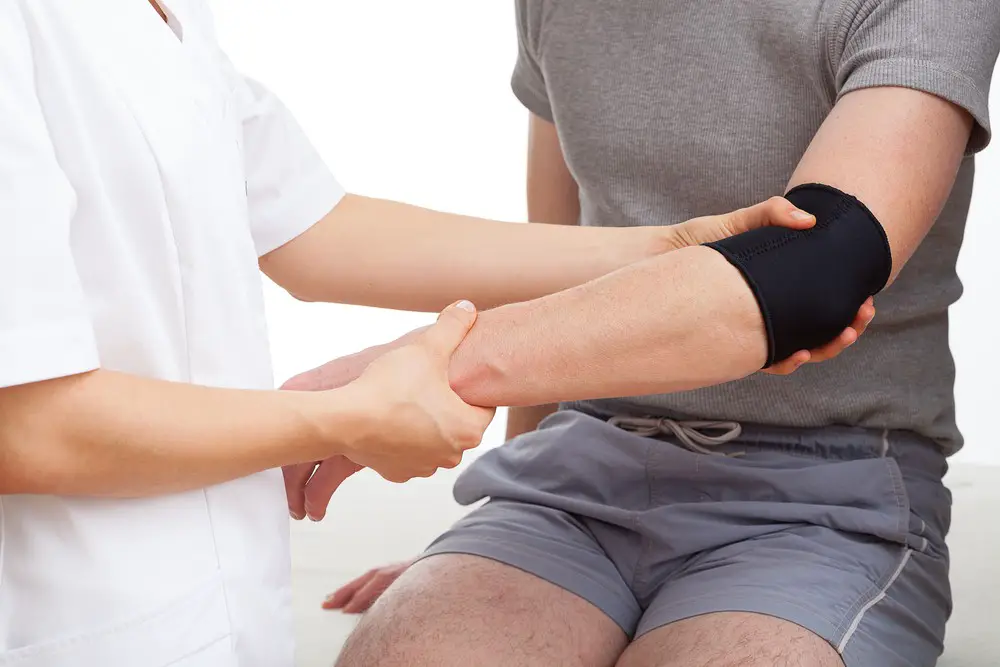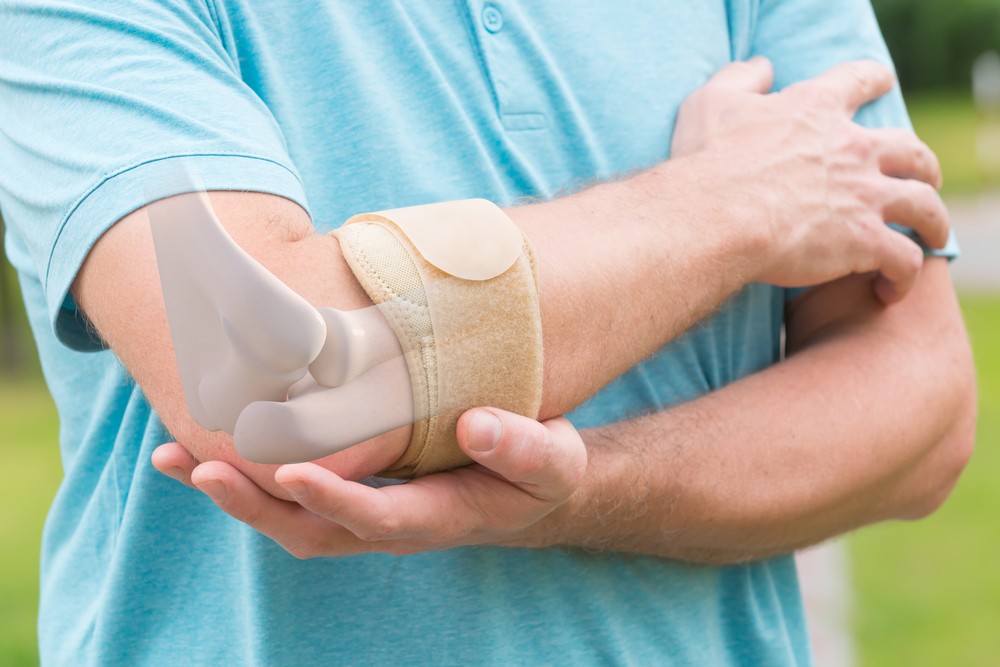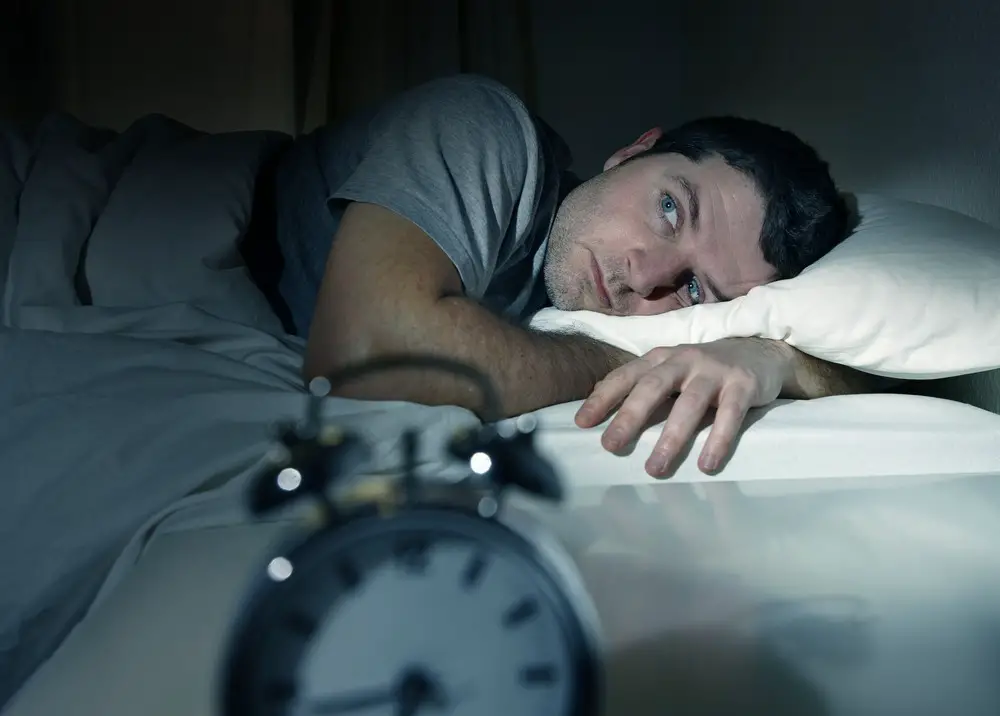As a BetterHelp affiliate, we receive compensation from BetterHelp if you purchase products or services through the links provided
Tennis elbow, also known as lateral epicondylitis, is a common condition that causes pain in the outer part of the elbow and can make daily activities, including sleep, challenging for those affected. This discomfort is due to inflammation and micro-tears in the tendons that connect the forearm muscles to the outer elbow joint. It is essential for individuals suffering from tennis elbow to find a comfortable sleep position that supports healing and promotes a good night’s rest.
Struggling to sleep with tennis elbow can lead to fatigue, increased pain, and slower recovery. Thankfully, various strategies can be employed to alleviate discomfort during sleep and accelerate the healing process. This article will discuss how to choose comfortable sleep positions, support and protect the injured arm and prevent further aggravation of the affected area.
Key Takeaways
- Discover comfortable sleep positions to ease tennis elbow discomfort
- Learn how to support and protect the injured arm during sleep
- Implement strategies to prevent further aggravation and promote recovery

Understanding Tennis Elbow
Causes and Symptoms
Tennis elbow, or lateral epicondylitis, is an overuse injury caused by repetitive stress on the forearm muscles. This stress often results from activities that involve gripping or twisting, such as tennis or other racquet sports. The injury occurs when microscopic tears form in the tendons that connect the forearm muscles to the lateral epicondyle (the bony bump on the outer side of the elbow).
Common symptoms of tennis elbow include:
- Pain and tenderness on the outside of the elbow
- Stiffness in the elbow joint
- Weakness in the forearm
- Difficulty gripping objects
Impact on Sleep
Tennis elbow can significantly impact a person’s sleep quality due to discomfort and pain. The pain may worsen at night, making it difficult to find a comfortable sleeping position. In some cases, the pain can disrupt their sleep, causing them to wake up frequently at night. This can lead to a lack of restorative sleep, leaving them feeling fatigued and impacting their daily activities.
Consider using pain management techniques and sleep-promoting strategies to improve sleep quality while dealing with tennis elbow. These include using over-the-counter pain relievers, incorporating gentle stretches, and maintaining a consistent sleep schedule.
Managing Pain and Discomfort
Medications and Topical Treatments
To manage pain and discomfort associated with tennis elbow, over-the-counter (OTC) medications, such as ibuprofen or naproxen, may help reduce inflammation and provide temporary relief. Always follow the recommended dosages and consult your healthcare provider if necessary.
Topical creams, such as those containing menthol or capsaicin, can also effectively relieve pain at the injury site. These creams create a sensation of warmth or coolness, which helps ease discomfort in the affected area.
Heat Therapy
Heat therapy can also aid in alleviating pain and promoting healing. Applying a heating pad or warm towel to the affected area for about 15-20 minutes several times a day can be beneficial. The heat helps to increase blood flow, relax muscles, and soothe pain. However, avoid applying heat immediately after the injury or if the area is still swollen, as it may worsen inflammation.
Comfortable Sleep Positions
Side Sleeping
For those experiencing tennis elbow, side sleeping can be a comfortable option if done with care. Sleep on the unaffected side to avoid placing pressure on the injured arm. The affected arm can be positioned in front of the body or placed on a pillow for extra support. This helps alleviate pain and prevents further strain on the elbow during sleep.
Back Sleeping
Back sleeping is another excellent option for individuals dealing with tennis elbow. The arm remains neutral by lying on the back, and the body’s weight is not applied to the affected elbow. Position the sore arm on a pillow by the side, ensuring the elbow remains elevated above the heart level. Keeping the elbow elevated helps in reducing inflammation and alleviating pain at night.
Adjusting the Pillow
Strategically using pillows can play a significant role in achieving a comfortable sleep position for those with tennis elbows. Ensure that your head and cervical spine are well-supported by a contoured pillow. Additionally, you can use a wedge-shaped pillow or a rolled-up towel under the affected arm for support. It is essential to make necessary adjustments to the pillows to attain an optimal sleep position and indirectly aid the healing of the injured elbow.

Supporting and Protecting the Injured Arm
Braces and Compression Sleeves
Supporting the injured arm is crucial when dealing with a tennis elbow. One way to provide support is by using braces or compression sleeves. These can help alleviate the stress on the elbow and ensure comfort while sleeping. Braces, in particular, provide a physical restraint that limits the movement of the arm, reducing the risk of further injury.
Compression sleeves, on the other hand, apply gentle pressure to the arm, promoting blood flow and providing support to the affected area. When selecting a brace or sleeve, choosing the appropriate size and fit is vital. Too loose won’t provide the needed support, and too tight could cause additional discomfort.
Elevating The Arm
Elevating the injured arm can help minimize the swelling and discomfort experienced with tennis elbow. By resting the arm on a pillow or specially designed wedge, one can:
- Reduce pressure on the affected area
- Improve blood circulation
- Limit unnecessary arm movement during sleep
Incorporating these simple yet effective techniques of using braces and compression sleeves and elevating the arm may significantly improve an individual’s comfort and support while sleeping with a tennis elbow.
Preventing Further Aggravation
Proper Sleep Hygiene
Maintaining proper sleep hygiene is essential for individuals suffering from tennis elbow. It is important to avoid sleeping with the affected arm under the pillow or head while resting, as this may lead to compression and increased pain. Elevating the injured elbow on a soft pillow or cushion during sleep can help alleviate discomfort and promote healing.
Appropriate Activities and Breaks
Individuals with tennis elbow need to be mindful of their daily activities. Limiting repetitive motions, such as playing tennis or golf, using a computer mouse, or shaking hands, can reduce the chances of further aggravation. Incorporating breaks during these activities is advisable, as continuous movement can exacerbate the condition. A simple nod or verbal acknowledgment is a safe alternative instead of bumping elbows as a greeting.
- Limit repetitive motions like playing tennis or golf
- Take breaks during activities involving the affected arm
- Avoid shaking hands or bumping elbows
Incorporating rest and movement in a balanced manner is crucial for preventing further injury. Rest periods allow the muscles and tendons around the elbow to recover and can decrease inflammation. On the other hand, gentle movement helps maintain flexibility and strength in the affected area, aiding overall recovery.

Rehabilitation and Recovery
Physiotherapy and Manual Therapy
Rehabilitation often begins with physiotherapy, which involves techniques to alleviate elbow pain and reduce strain on the tendons. A physiotherapist can also assess the condition of the upper arm muscles, back, and forearm to identify any underlying issues contributing to the tennis elbow. Manual therapy, such as massage, can help break down scar tissue and adhesions, thereby improving blood flow, oxygenation, and collagen synthesis in the affected area.
Exercises and Stretches
Incorporating appropriate exercises and stretches into the recovery process is crucial for regaining strength in the injured tendons and surrounding upper arm muscles. Simple exercises, such as wrist extensions and forearm rotations, can be performed to rebuild strength, while gradually stretching the lateral elbow area can help maintain flexibility and prevent stiffness in the long run.
Monitoring symptoms such as dull aches, sharp pain, soreness, numbness, and chronic pain is essential during rehabilitation. It is important to adjust the intensity and frequency of exercises according to the individual’s response and consult a physiotherapist to ensure proper execution of the movements.
Additional treatment options for tennis elbow may include medications to manage discomfort, addressing underlying conditions such as obesity, diabetes, and hypertension, and adjusting daily activities.
Sleep Positions for Tennis Elbow
Finding a pain-free position for sleeping is vital for individuals with tennis elbows. A helpful sleeping position is to keep the affected arm overhead with the support of a pillow, which can help alleviate strain on the tendons and wrist. Some people may find relief by sleeping on their back, using pillows for support, and keeping the elbow elevated. Adjusting sleep positions can improve comfort and allow for a better night’s rest, contributing to overall recovery.
Frequently Asked Questions
What is the best sleeping position?
The most comfortable and effective sleeping position may vary for individuals with tennis elbow. However, typically it is suggested they sleep on their back with a small pillow supporting the affected arm.
How should I keep my Arm: straight or bent?
Keeping the arm slightly bent while sleeping is usually recommended for those with tennis elbows. This helps reduce tension on the tendons and allows for better circulation in the arm.
Should I wear a brace at night?
Wearing a brace designed for tennis elbow during sleep can help with pain and discomfort. It provides support and compression, limiting the stress on the affected tendons. However, consult with a healthcare professional before using a brace at night.
Is there a tennis elbow quick cure?
Unfortunately, there is no quick cure for tennis elbow. Proper rest, avoiding activities that cause pain, and following an appropriate exercise and stretching regimen can help alleviate the symptoms. Consult with a healthcare professional for personalized guidance on treatment.
How do I avoid elbow pain?
Taking breaks during activities involving repetitive arm motions is essential to prevent aggravating tennis elbow. Implementing proper technique, using appropriate equipment, and maintaining a regular exercise regimen to strengthen the arm muscles can also reduce the risk of tennis elbow.
Effective exercises
A consistent exercise routine targeting the arm muscles can aid tennis elbow recovery. Some effective exercises include wrist extensions, wrist curls, forearm supination, and pronation. Perform these exercises with light resistance and consult a healthcare professional to ensure they are done correctly.
- 3 Ways Wearing a Hat Can Help Lower Your Stress Levels - April 19, 2025
- Breaking the Silence: Why Men’s Mental Health Matters More Than Ever - April 15, 2025
- How to Transform a Home’s Patio Space into a Relaxing Space - March 23, 2025
This site contains affiliate links to products. We will receive a commission for purchases made through these links.



